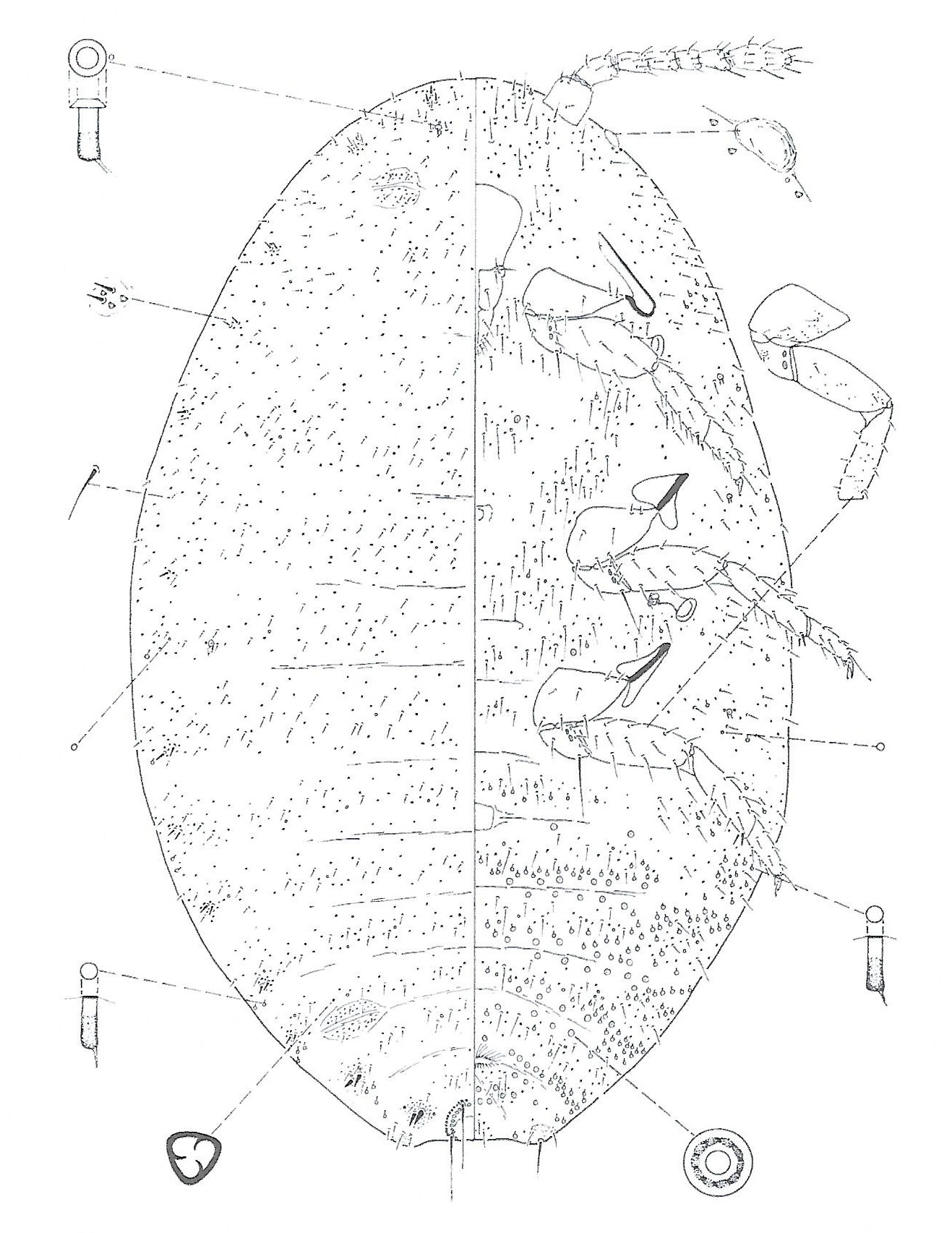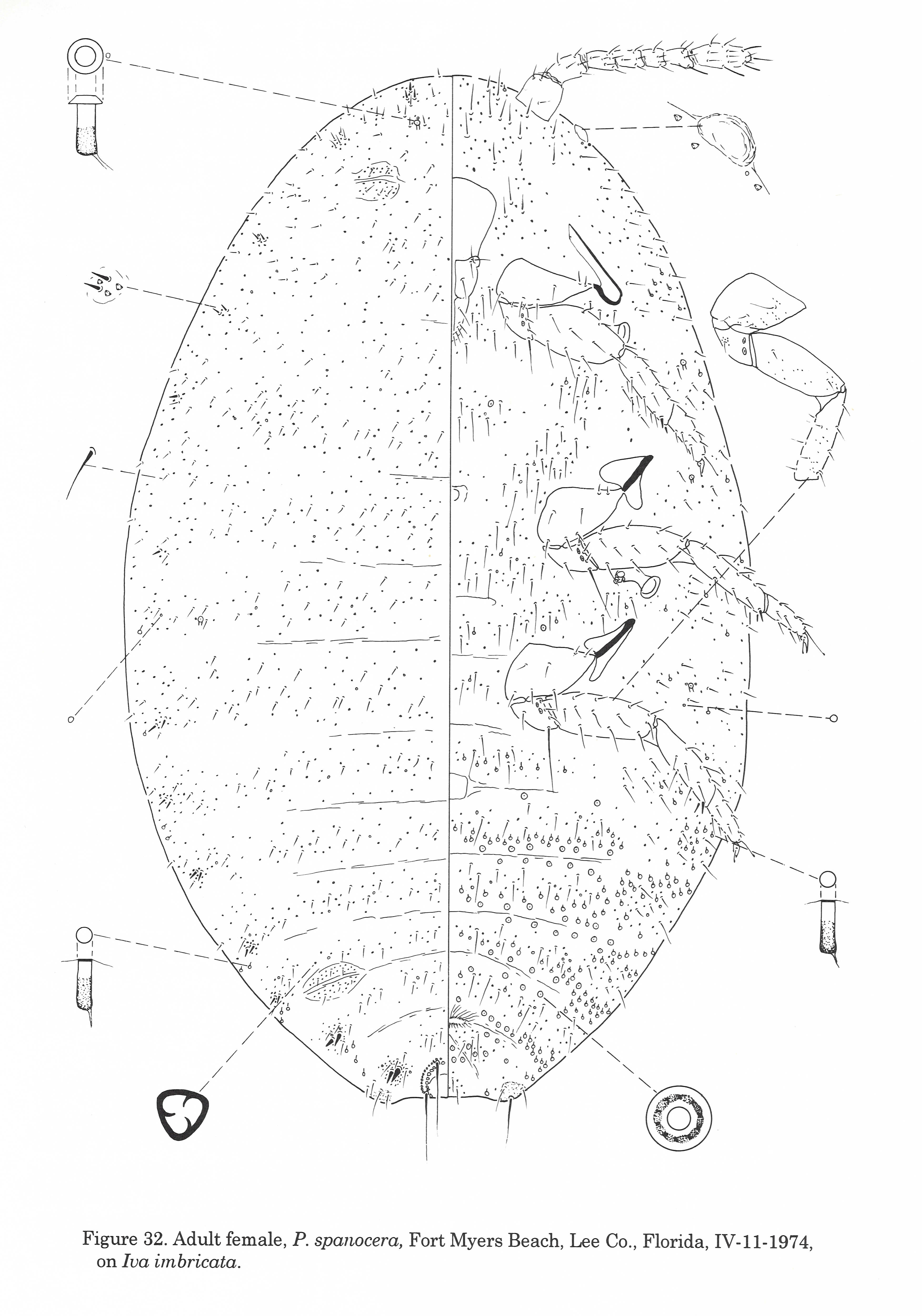Valid Names Results
Pseudococcus spanocera Gimpel & Miller, 1996 (Pseudococcidae: Pseudococcus)Nomenclatural History
- Pseudococcus spanocera Gimpel & Miller 1996: 126. Type data: U.S.A.: Florida, Lee County, Ft. Myers Beach, on Flaveria sp.. Holotype, female, Type depository: Washington: United States National Entomological Collection, U.S. National Museum of Natural History, District of Columbia, USA; accepted valid name Illustr.
Common Names
- Florida trochanter mealybug GimpelMi1996
Ecological Associates
Hosts:
Families: 8 | Genera: 14
- Amaryllidaceae
- Narcissus | GimpelMi1996
- Asteraceae
- Ambrosia artemisiifolia | GimpelMi1996
- Bidens | GimpelMi1996
- Flaveria | GimpelMi1996
- Iva imbricata | GimpelMi1996
- Pityopsis graminifolia | GimpelMi1996 | (= Chrysopsis graminifolia)
- Buxaceae
- Buxus | GimpelMi1996
- Cyperaceae
- Cyperus | GimpelMi1996
- Rhynchospora microcephala | GimpelMi1996
- Ericaceae
- Rhododendron | GimpelMi1996
- Fabaceae
- Aeschynomene pratensis | GimpelMi1996
- Glycine max | GimpelMi1996
- Plantaginaceae
- Scoparia dulcis | GimpelMi1996
- Polygonaceae
- Rumex pulcher | GranarGo2018
Geographic Distribution
Countries: 2
- Argentina | GranarGo2018
- United States
- Arkansas | GimpelMi1996
- Florida | GimpelMi1996
- Georgia | GimpelMi1996
Keys
- GranarGo2018: pp.10-14 ( Adult (F) ) [Central & South American Pseudococcus]
- VonEllWa2016: pp.74-75 ( Adult (F) ) [Pseudococcus species present in the New World]
- GimpelMi1996: pp.18 ( Adult (F) ) [World]
Remarks
- Systematics: P. spanocera has 1-4 tubular ducts with oral rims all over the dorsum, sometimes only on one side of the body (P. sorghiellus has 3-31 ducts on the abdomen); 2) tubular ducts without oral rims between C2 and C3 (normally present in P. sorghiellus); 3) 0-1 tubular ducts with oral rims on the thorax (marginal, lateral and submedial in P. sorghiellus); 4) 0-3 conduits with oral border, submarginal in the abdomen, (submarginal, lateral and medial in P. sorghiellus); 4) antennas with 7-8 segments, IV can be partially divided (antennas with eight segments in P. sorghiellus); and 5) cerarii17 to 15 pairs of cerarii since C4 and C8 can be reduced (P. sorghiellus with 17). (Granara de Willink & González, 2018)
- Structure: Circulus small located on segment III; translucent pores inconspicuous, usually present on hind coxa, trochanter, femur, tibia; antennae 7-segmented; 11(13-16) pairs of cerarii; 4(0-13) dorsal oral rims. (Gimpel & Miller, 1996) Translucent pores on coccyx, trochanter, femur and tibia; eyes with 1-2 discoidal pores on membranous surface; cerarii less than 17 pairs; C16 and C17 on a slightly sclerotiz surface; 0-13 tubular canals with a conspicuous oral rims associated with a seta and / or discoid pore; always absent between C2 and C3, present in dorsal abdomen, ducts with oral collar scarce in area cephalic and ventral thorax, (Granara de Willink & González, 2018)
- General Remarks: Good description and illustration of the adult female given by Gimpel & Miller (1996).
Illustrations
Citations
- GimpelMi1996: description, distribution, host, illustration, taxonomy, 126-130
- GranarGo2018: diagnosis, distribution, host, illustration, key, taxonomy, 8, 10-14, 45-46
- VonEllWa2016: key, 75




